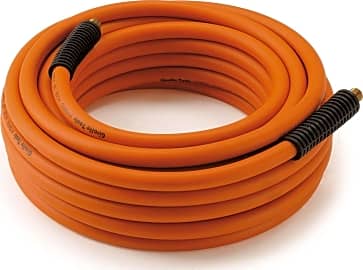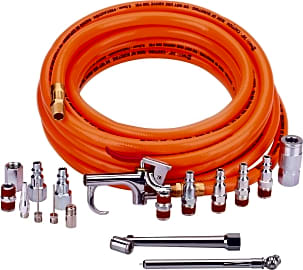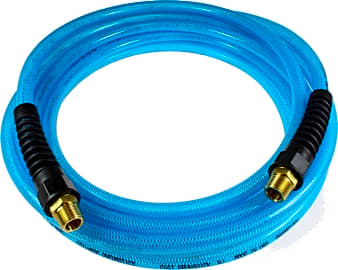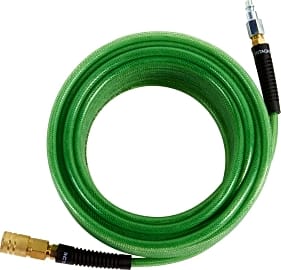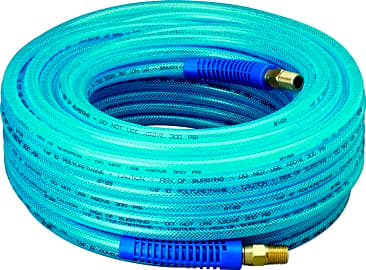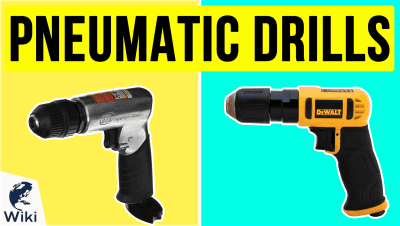The 10 Best Air Hoses

This wiki has been updated 35 times since it was first published in May of 2016. Pneumatic tools can be utilized for an array of tasks around the house, at a construction site, or in a workshop. But you'll need to pick up one of these air hoses first, as they deliver the power to paint sprayers, nail guns, tire inflators, buffers, stapling guns, grinders, drills, jack hammers, and more. Pressurized vessels are dangerous, so observe all safety protocols to avoid injury. When users buy our independently chosen editorial selections, we may earn commissions to help fund the Wiki.
Editor's Notes
May 17, 2021:
In a category that’s notorious for poorly manufactured goods that essentially amount to unintentionally disposable equipment, we thought the last editor for this page did a nice job of rounding up a varied selection of quality options from well-reputed brand names, and we didn’t see any need to make many changes. We did, however, notice that the Campbell Hausfeld PA121000 wasn’t available during this update.
We were careful when searching for an appropriate replacement for the PA121000, as we wanted to make sure that we selected another recoil model, and we eventually settled on the Flexzilla Recoil LP1425AFZ, which is offered in four lengths and sports a 16-inch tail with a swivel fitting.
With a 120-PSI maximum pressure rating, it isn’t built for heavy duty the way some of our other models are – the Wynnsky 1016 and the LP1245AFZ’s big brother the Flexzilla ZillaGreen can both handle 300-PSI pressures – but it is equipped well enough for occasional use and will deliver as much utility as the average homeowner is likely to need. It also makes a good addition to emergency road kits.
Now that you’ve gone and got a new hose picked out, you may as well get started on selecting your aspirational air compressor. And, if you’re planning on this hose living long-term in your garage of workshop, then you might find that you’re a lot happier with an option from our list of air hose reels.
March 26, 2020:
Removed the PowRyte Hybrid and the DuRyte Pro because of availability concerns.
Added the Blubird BB3835 and the Campbell Hausfeld PA121000.
Hoses can be built out of a variety of materials and each has its benefits and drawbacks. So, for example, if you're looking for an ultra-flexible hose with high pressure resistance, you should look to rubber hoses like the Blubird BB3835 or the Tekton 46338. Polyurethane hoses like the Campbell Hausfeld PA121000 have excellent abrasion and puncture resistance, along with having a very low weight. Hybrid hoses like the Flexzilla ZillaGreen combine the light weight of PVC and the flexibility of rubber.
For compressed air applications, you should look for hoses and compressors that come with national pipe thread (NPT) fittings with tapered threads, as these greatly outperform straight thread fittings. NPT fittings like those included with the Blubird have tapered threads that produce a solid seal when tightened. When leaks do appear, you can often get away with simply torquing the fitting a bit more.
Pressure vessels are dangerous and all safety precautions should be taken to avoid personal injury.
Special Honors
Air Compressors Direct No amount of hoses are going to do you any good without a decent compressor to power them. This company has hundreds of options to choose from, split among more than a dozen styles, and they make it easy to search by brand, capacity or horsepower rating. aircompressorsdirect.com
Compressor World For on-site applications, like roofing and installing siding, you can often get away with rolling up to a job with a compressor and bare hose. But for professionals setting themselves up for a long-term operation in a workshop setting, hose reels provide a civilized way to keep things tidy, and this company has more than 300 to choose from. compressorworld.com
Using One Of Life’s Essentials To Your Advantage
Removing wheel nuts, changing out a fuel filter, or installing a new valve requires far less time and effort when you swap out your old-school tools for air-powered ones.
Air: it’s free, it’s abundant, and it keeps us alive.
As if that isn’t enough, we can use an air compressor to pressurize it, giving us the ability to power pneumatic tools, breathe underwater, fill up our tires, spray paint our homes, dust blow our patios, ferment food and beverages, and perform a host of other useful tasks.
We’ll get into the science of air compression later; for now, we’ll highlight the benefits you can enjoy as long as you’re in possession of two simple items: an air compressor and an air hose.
When people consider air power, pneumatic tools seem to come to mind right off the bat. Name a power tool — hammer, drill, nail gun, sander, saw, and everything in between — nearly all of them are available as air-powered models. Plenty of professional contractors and do-it-yourself handymen prefer these to their electric and battery-powered counterparts because they’re typically lighter, easier to maneuver, and equally powerful.
Even if you’re an amateur at best when it comes to working with cars, you can forego a visit to the pricey mechanic and save some cash by utilizing specific air impact tools for do-it-yourself auto repairs. Removing wheel nuts, changing out a fuel filter, or installing a new valve requires far less time and effort when you swap out your old-school tools for air-powered ones.
If you’ve ever stopped by the gas station to inflate your vehicle’s tires, you likely arrived at the service station to discover an old, tangled air hose in some state of disrepair. With your own air hose, you can fill up your tires on your own time — as well as re-seat pneumatic tires on your riding lawnmower, wheelbarrow, ATV, or any similar piece of wheeled equipment.
A quality air hose also allows you to apply liquid substances like herbicides and pesticides, use a sandblaster to remove rust from metal, flush out your swimming pool lines, power a spray paint gun, or operate a potent air-powered vacuum cleaner for particularly messy jobs.
You’ve always known air was important, but did you ever realize it was this convenient?
The Right Hose Shouldn’t Be Hard To Find
You could be looking to invest in your first air hose, or maybe you’ve owned one for years, except you’ve squeezed every last ounce of use out of it to the point that it is now a dilapidated shell of its former self, like the shriveled skin a snake leaves behind after a shedding.
In either case, you need a new hose. To find the ideal one, start by asking yourself a few basic questions.
What length of hose do you need? Before you go out and buy a 100-foot model because of its extensive reach, keep in mind that the longer the air has to travel through your hose, the more pressure it will lose during the process. Think about the space in which you’ll be using it and the amount of power you’re going to require, and try to strike a balance between maneuverability and potential pressure loss.
Rubber hoses are tough, heavy, and abrasion-resistant, so they’ll stand up to substantial use and get the job done in most weather conditions.
What is the ideal internal diameter? This notion isn’t too complicated — the larger the diameter of the hose, the more air it will be capable of carrying. Take into consideration the CFM requirements of the tools you plan to use and weigh that into your decision. Common sizes include six, eight, and 10 millimeters.
Which material works best? Each hose material offers pros and cons in terms of durability, flexibility, weight, resistance to kinking, and performance in cold weather.
Nylon isn’t particularly durable, but it’s lightweight and works well as a recoil hose. PVC models are a bit tougher, but they tend to coil and kink and they don’t hold up very well in cold weather. If you’re on a budget and need something for light use, a PVC hose is a solid bet.
Rubber hoses are tough, heavy, and abrasion-resistant, so they’ll stand up to substantial use and get the job done in most weather conditions. Polyurethane hoses, while fairly rigid and prone to kinking, offer excellent flexibility, strong cold weather performance, and impressive longevity. They’re a bit pricier than some of the other styles, but you should be able to find a nice value.
Do you want a standard or recoil hose? Your personal preference will dictate which type you choose. A standard hose lies flat, with no bends or coils, allowing you to wind it up on a reel or manually wrap it up in loops for storage. Designed with small coils that have memory, a recoil hose will shrink back up on its own when you let go of it, making it quite easy to pack up and store.
When you select a hose, don’t forget to examine the fittings that come with it. High-quality, durable fittings are essential, as flimsy ones that break down easily will quickly lead to air loss. If the included fittings look subpar, go out and pick up a few on your own.
What Is Compressed Air And How Does It Work?
In essence, when you refer to air as compressed, you’re simply indicating that the air is being kept at a pressure level that is greater than atmospheric pressure.
The system consists of a motor, cylinder, piston, crankshaft, valve head, and connecting rod.
As the pressure of air rises, the volume drops. An air compressor typically accomplishes this through reciprocating piston technology. The system consists of a motor, cylinder, piston, crankshaft, valve head, and connecting rod.
At each end of the top of the cylinder, you’ll find inlet and discharge valves — which are essentially metal flaps — that suck in the air for compression, then release it. In some models, rotating impellers generate the air pressure, while others use positive displacement pumps.
With its back-and-forth movements, the piston creates a vacuum, retracting until the front compartment fills with air. When it extends, it compresses the air and pushes it through the discharge valve into a tank, which stores the air within the specified pressure range until it’s ready to dispel into the hose. The motor powers this whole process, starting and stopping to keep the pressure in its ideal range.



